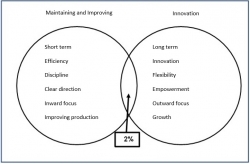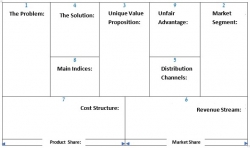Around the end of every year I get questions about creating a work-plan for the upcoming year.
First, I'd like to point out that the very end of the year is too late to start working on a yearly-plan for the next year. Additionally, it is better to base yearly plans on a larger, multi-year plan.
Working without a multi-year plan is like driving a car without headlights
Recently my son taught me this metaphor, that working without a multi-year plan is the equivalent of driving without headlights.
Think how we feel driving in the dark with no headlights, and how similar that is to working without a plan for the following year, and the one after that, and the one after that…
The business world is full of urgent matters. Every day we come to the office, we are met with brand new problems to solve and new decisions to make.in the daily course of things, it's easy to confuse urgent things that need our immediate attention, and things that are important for the long-term success of our company.
If we neglect the urgent things, we may lose in the short-term. But if we neglect the important things, we may lose our entire business in the long-term.
Those important things are determined by our vision.
You're undecided about moving forward with a project that will show results only in a few months, a year, or two years, but don’t have a sales- or work-plan for that time. How can you make a decision?
Investments pay off, if we're lucky, in two to three years. How can we make an investment-plan if we don’t have a work-plan for the next three or five years, at least?
A Step-by-Step Guide
So let's start with the long-term, and a five-year plan.
1. Define a sales goal for the year 2024 (five years from now)
2. Take one step back and define a goal for 2023
3. Do the same for 2022, 2021, and 2020
4. Now analyze growth distribution between this year (2019) and the goal year (2024)
If necessary, change the yearly sales goals over the five years, without changing the goal for the final year (2024).
If you're planning a significant jump in sales over the period, think how you'll make it happen. What will you need? Perhaps investing in new equipment, or technology, perhaps developing new products? If a significant purchase or innovation is required, consider postponing the jump to the third year.
5. Next, create monthly sales goals for 2020, so the total sales will amount to your planned yearly goals
Take into account seasonal changes (holidays, summer vacation, etc.) and remember that between December of one year and January of the next you shouldn’t see a jump, but continual growth.
6. Once you've completed planning your sales goals for the period, determine for every year what your means for generating sales will be
Meaning which products or markets (for example, new clients or new products).
I recommend working with the quarters method:
| IV | III |
| new clients new products |
existing clients new products |
| II | I |
| new clients existing products |
existing clients existing products |
Explanation: when we want to grow sales, we'll start with the bottom left quarter (I): existing clients and existing products (that is, clients who used to purchase from us and stopped, or clients who only purchase some of our products – maybe they're unfamiliar with our full range?).
Then we'll move on to new clients and existing products (quarter II), and afterwards examine how we can develop new products to offer to existing clients (quarter III).
Finally, we'll strategize how to reach new clients with new products (quarter IV, upper right corner).
I suggest this part be led by the sales manager with their team, and be approved by the CEO.
Even though the sales department carries out the sales-plan, I recommend you hold at least one workshop with representatives from other departments, in order to gather as many new ideas as possible.
New ideas always come from people who aren’t usually involved in discussions.
7. Once we're done planning sales goals, we'll examine what we'll need in order to achieve them
this time from the aspect of material purchasing, manufacturing, development, sales, management (etc.) costs. In short, we'll fill out a kind of cost-gains report based on sales goals, costs in every aspect, and of course our streamlining plans.
8. This part I recommend be the responsibility of department heads
(operations, supply chain, etc.), each with their team, and bring to the CEO's approval.
It's proper that the CEO sets streamlining goals for every VP, who builds a plan accordingly.
9. Next step
Now that you have detailed monthly sales goals, a sales development plan according to the quarters method, and a full streamlining plan, all that's left is to build a full plan to follow.
Such a plan will be prepared by each VP with their team, and it's recommended you involve as many managers and employees.
The more employees are involved, the more they'll be invested in the outcome and work towards achieving goals.
10. Goals and indicators
once the plan is complete, determine your main goals and (measurable!!!) indicators that will enable you to monitor progress.
Don't skip the indicators. If you don’t measure and monitor progress the chance of you actually achieving your goals is very low.
Summary and Recommendations
Any yearly work-plan must be based on a multi-year plan.
The multi-year plan needs to follow the company's vision and the strategy set to achieve it. In this article I didn’t discuss setting a vision and strategy.
Without monitoring the plan's progress its chances of success are very low. Set goals and indicators and a monitoring routine. For example, a monthly meeting of management, and more frequent checks by VPs.
I presented a suggested step-by-step guide and I recommend you don’t take shortcuts and don’t plan only for the upcoming year.
I again strongly recommend you involve a large number of middle-management and employees in discussions. This way, you'll receive the benefit of new ideas, while also creating in your employees an investment in the plan's success.
As always, I'm here to assist and answer questions.












 My First Book: Manage! Best Value Practices for Effective Management
My First Book: Manage! Best Value Practices for Effective Management